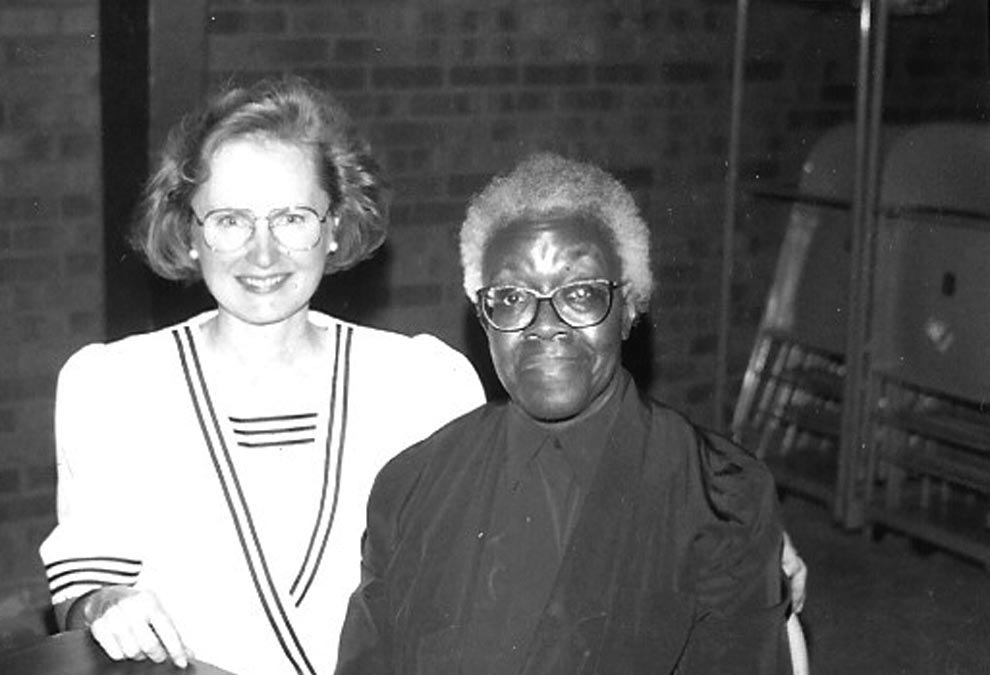
“Language should be used with care and precision.” —Gwendolyn Brooks

It began as a warm and sun-filled early Summer day in 1991.
I had to conduct a night basic reading training so I would not have to arrive at the campus until 1 p.m. That would give me time to drive to Yorkville and meet poet, author, teacher Gwendolyn Brooks. She seemed very shy and quiet. I asked if I could have a photo with her and she nodded yes. The result is on this page. I raced back to campus to arrive on time.
When her first book of poetry, “A Street in Bronzeville (1945)” was being published by Harper & Brothers, author Richard Wright was asked by the editor what his opinion was of her work and he wrote that, “There is no self-pity here, not a striving for effects. She takes hold of reality as it is and renders it faithfully. She easily catches the pathos of petty destinies, the whimper of the wounded. The tiny accidents that plague the lives of the desperately poor and the problem of color prejudice among Negroes.”
Born in Topeka, Kan. June 7, 1917, Brooks moved with her family to Chicago when she was six-weeks-old. When she was 13 years old, her first poem to be published was “Eventide” in a children’s magazine American Childhood. By the age of 16, she had written and published 75 poems. She was graduated from Wilson Junior College in Chicago which is now known as Kennedy-King College. She worked as a typist to support herself while she wrote. “I am not a scholar,” she later said. “I’m just a writer who loves to write and will always write.”
Brooks married Henry Blakely, Jr. in 1939 and they had two children Henry and Nora. Henry died in 1996. When two of her poems were published in Poetry magazine, she described her occupation as a “housewife.”
Gwendolyn Brooks won the Pulitzer Prize for Poetry May 1, 1950 for “Annie Allen,” to make her the first African American to receive the Pulitzer. “Annie Allen” follows the life of Annie, an African American, from birth to womanhood, as she seeks self-awareness and fulfillment. It is rare poetic art.
She was appointed Poet Laureate of Illinois in 1968 and held the position until her death. In 1976 she became the first African American woman inducted into the American Academy of Arts and Letters.
Her list of honors and legacy is formidable: A 1946 Guggenheim Fellow in Poetry, a 1969 Anisfield-Wolf Book Award, in 1988 inducted into the National Women’s Hall of Fame, awarded the Robert Frost Medal for lifetime achievement by the Poetry Society of America, presented with the National Medal of Arts, and in 1997 awarded the Order of Lincoln, the highest honor granted in Illinois.
She was inducted into the Chicago Literary Hall of Fame in 2010 and in 2012 was honored on a United States postage stamp. She was named to the 100 Greatest African Americans in 2002, the Gwendolyn Brooks Middle School was named in her honor in Oak Park, and so was the Gwendolyn Brooks College Prep Academy High School on the far South Side of Chicago.
A statue and memorial honor this legacy in the North Kenwood Park that shares her name. The installation includes a replica of Brooks’ outdoor office, the porch where she would contemplate and write. Some of those words are engraved on a pathway of stones featuring lines from her poems. “Life was little as a sand. Little as an inch of song.”
Gwendolyn Brooks died December 3, 2000 at age 83 in Chicago.

